Castor is the second-brightest star in the zodiac constellation of Gemini. It is also the 23rd brightest star in the night sky and its actually a sextuple star system.
Key Facts & Summary
- Castor is organized into three binary pairs, made up of the stars Castor Aa, Ab, Ba, Bb, Ca, and Castor Cb.
- Through its large annual parallax, it has been determined that Castor is 51 light-years / 15.6 parsecs away from the Sun.
- The combined visual magnitude of all the stars is +1.58. The primary pair, Castor A has an apparent magnitude of 1.93, Castor B has an apparent magnitude of 2.97, while Castor C is the faintest at around 9.83.
- Castor A is the brightest pair of stars. Both stars are A-class main-sequence stars that are brighter, and more massive than the Sun.
- Castor B is formed by a white main-sequence star and a red dwarf. The bigger star is classified as an Am star which is a chemically peculiar class A star with strong metal absorption lines in its spectrum.
- Castor C is the faintest pair that is made up of two red dwarfs that combined, are around half the mass of the sun.
- Castor C is an eclipsing binary system, each star eclipses the other periodically.
- Castor is slightly fainter than Regulus, Adhara, and it outshines Shaula, Gacrux, and Bellatrix.
- The biggest stars are Castor Aa and Ba. Castor Aa has around 2.76 solar masses and around 2.4 solar radii.
- Castor Ba is more massive and bigger, having around 2.98 solar masses, and also 3.3 solar radii.
- The next two components, Castor Ca and Cb both have similar characteristics.
- They have around 0.59 solar masses, and around 0.6 solar radii, much smaller than our sun. They are also very faint, having around 0.73 solar luminosities and are much cooler than our sun, with surface temperatures at around 3.820 K.
- The bigger stars, Castor Aa and Ba, are hotter than our Sun, with estimated surface temperatures of around 10.286 K and 8.842 K.
Though Castor is designated as the alpha star of its constellation, it is, in fact, Pollux– Beta Geminorum – who is the brightest star. Usually, when these designations were provided, it was not necessarily based on the star’s luminosity. However, this might also suggest that one or maybe both stars have altered in brightness since their designation around 300 years ago.
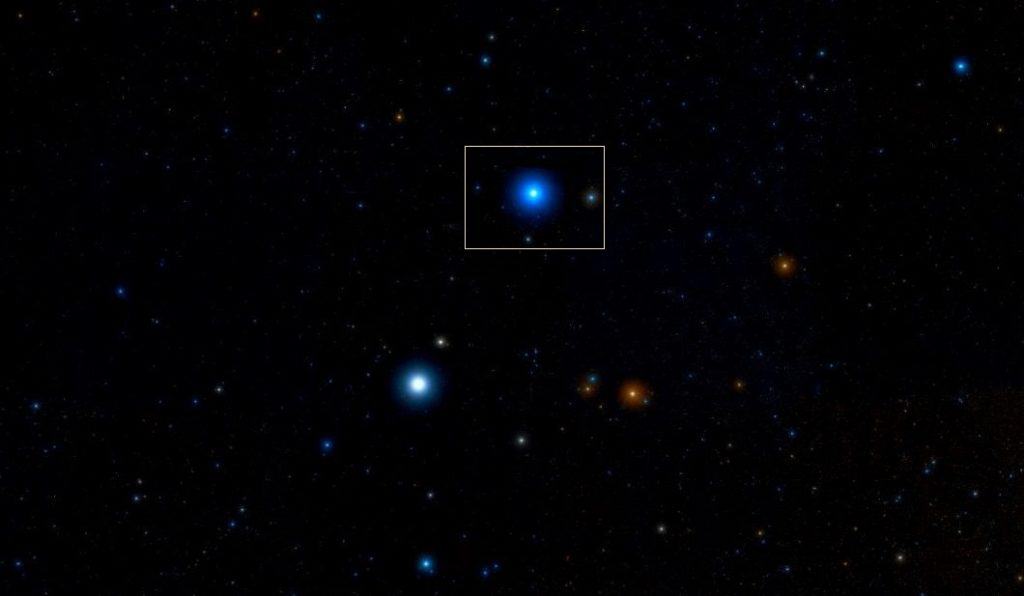
Pollux along with Castor, are the two main guideposts for the asterism nicknamed the Twins. The name Castor comes from a legend from both the Greek and Latin – Roman cultures. Pollux and Castor were twins and they were called Dioscuri in Greek, and the Gemini in Latin. The twins would help sailors in their time of need.
In Greek mythology, Pollux was one of two brothers who appeared prominently among Jason’s Argonauts. Both Pollux and Castor were the sons of Leda, the queen of Sparta.
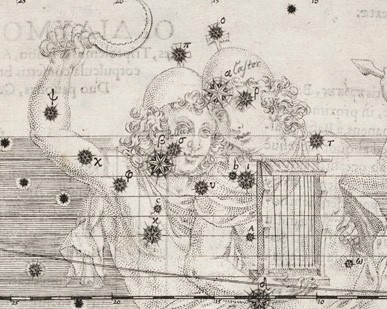
They had different fathers though, Castor had a mortal father and was thus mortal himself, while Pollux was the son of Zeus and was thus immortal. They also had a sister, the famous Helen of Troy.
In a battle, Castor supposedly died and Pollux begged Zeus to let him die and be reunited with his brother. Zeus couldn’t grant his wish since he was immortal.
He decreed that Pollux would stay in Olympus for some periods of time while also he was permitted to visit his brother in the underworld. Since Zeus was admiring Pollux’s brotherly love, he honored it and placed their constellation in the sky as a remembrance.
Formation
Castor formed million years ago, most likely from a cloud of dust and gas. The gravity pulled together the swirling gas and dust to make the star that we see today as the second-brightest star of the Gemini constellation. It is unknown if the star in this sextuple system formed at the same time, or during different time periods.
Determining its exact age is still a matter of debate among the scientific community. For example, Castor was believed to be part of the Castor Moving Grop. A group of stars that share a common origin and motion through space, speculated to be around 200 to 300 million years old. This was eventually disproved as Castor had a different velocity and the stars were even more separated by around 10 million years ago. The smallest stars, Castor Ca and Cb, have been estimated to be around 370 million years old.
Distance, Size, and Mass
Through Castor’s large annual parallax, it has been determined that the star system is 51 light-years / 15.6 parsecs away from the Sun. The two biggest stars Castor Aa and Ba, are both several times bigger than our sun.
The biggest and most massive star of the Castor system is Castor Ba. It has around 2.98 solar masses and a radius of around 3.3 solar radii. Thus, it’s diameter may be more than 6 times bigger than the suns.
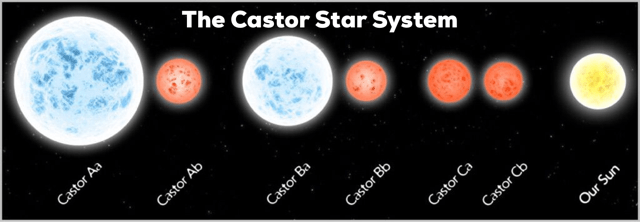
The second-biggest massive star is Castor Aa. It has around 2.76 solar masses and a radius of around 2.4 solar radii. Its diameter is estimated to be around 5 times bigger than that of the sun.
The smallest stars are Castor Ca and Cb. They have almost identical physical properties. Both stars are smaller than the sun, with an estimated radius of 0.61 solar radii. They are also less massive than our sun, with an estimated 0.59 solar masses.
Other Characteristics
The primary pair, Castor A, has an apparent magnitude of 1.93, and an absolute magnitude of +0.9. Both stars are A-class main-sequence stars of spectral type A1V and Am. They have a radial velocity of around + 6.0 km / 3.7 mi per second. Castor Aa is the smallest of the pair, but it is hotter. It has surface temperatures of around 10.286 K, almost twice as hot as our sun. It is also the slowest spinner, having a rotational velocity of 18 km / 11 mi per second.
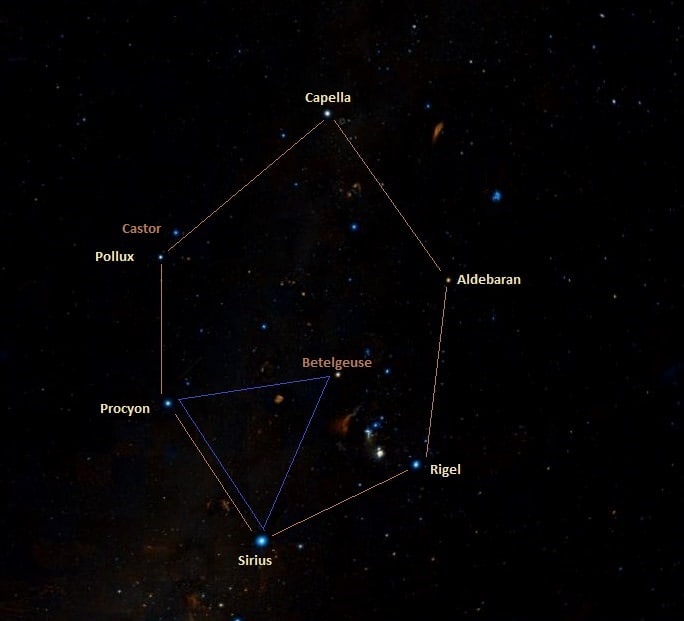
Castor Ba is the biggest star in the system. It is also the second-hottest with surface temperatures of around 8.842, much hotter than our sun. It spins almost twice as fast as its companion, with an estimated rotational velocity of 33 km / 20.5 mi per second.
The secondary pair of stars, Castor B, has an apparent magnitude of 2.97, and an absolute magnitude of +1.8. Castor B is formed by a white main-sequence star and a red dwarf. The bigger star, Castor Ba is classified as an Am star which is a chemically peculiar class A star with strong metal absorption lines in its spectrum. The other star is classified as a Dm1e star. Their radial velocity is estimated to be around – 1.2 km / 0.7 mi per second. There are fainter than our sun, with an estimated 0.07 solar luminosities. They are also cooler than our sun, at around 3.820 K. They have rotational velocities of around 37 km / 22.9 mi per second.
The third pair of stars, Castor C, is the faintest with an apparent magnitude of 9.83, and an absolute magnitude of +8.9. Castor C is an eclipsing binary system, each star eclipses the other periodically. It is composed out of two red dwarf stars. They have a radial velocity of around +2.5 km / 1.5 mi per second.
Stellar System
Castor C is an eclipsing binary system with an orbital period of less than a day. They are classified as a BY Draconis variable star since they eclipse each other during their orbit.
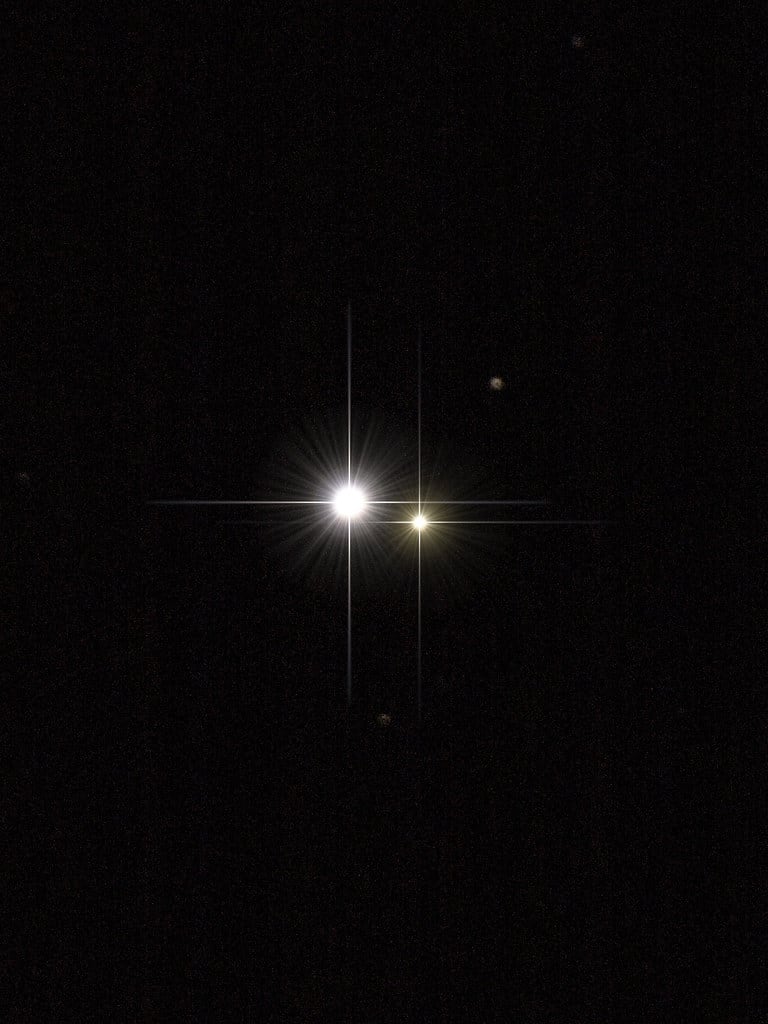
They have areas of different brightness that also contributes to the system’s variability. C completes an orbit around the Castor AB pari every several thousands of years and it is separated from them by around 73 seconds of arc. The average separation of A to B is around 100 AU.
Location
Castor is located in the zodiac constellation Gemini. The star is most prominent in the winter sky in northern latitudes. Castor is located near the winter asterism known as the Winter Circle or Winter Hexagon, which is formed by Pollux, Capella, Aldebaran, Sirius, and Procyon.
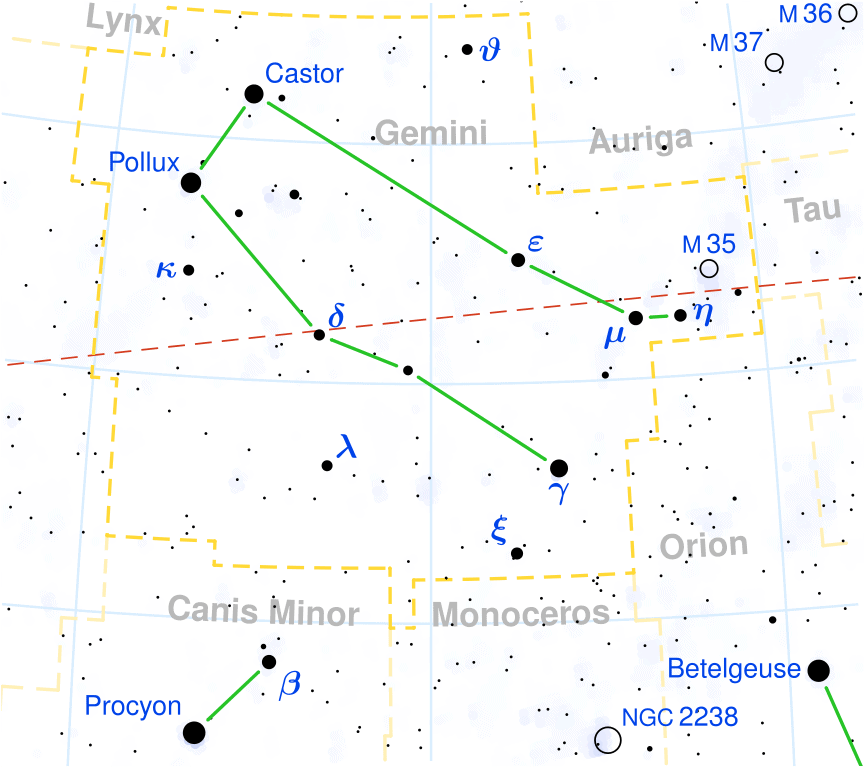
Pollux and Castor are around 18 light-years apart from one another. Probably the best month to observe the constellation and all its deep-sky objects and stars is in the month of February – this is when it is the most prominent.
The Future
The Castor star system is an interesting and complex one. In regards to Castor Aa, its spectral type is an indication that the star is nearing the end of its hydrogen fusing period. Though the A system is separated from B by around 6 arcseconds, this distance will continue to grow to a maximum of 6.5 arcseconds in the year 2100.
Did you know?
- Castor, and by extension Pollux, are sometimes identified with Apollo and Hercules or even with the founders of Rome – the brothers Romulus and Remus.
- Many cultures associate Pollux and Castor as twins. However, in India, they were the Horsemen, and in Phoenicia, they were two gazelles or two kid-goats.
- In China, the stars were associated with Yin and Yang. Most cultures represent the stars as two of something.
- Though they appear similar in brightness and are often referred to as twins, Pollux is a single star while Castor is a star system consisting of six.
- The constellation of Gemini is the northernmost of the zodiacal constellations and among the brightest.
- The Chinese knew Castor as the Second Star of North River – an asterism formed by Castor, Pollux, and Rho Geminorum.
- The Arabs knew Castor as the “head of the foremost twin” while the Babylonians knew Castor as the Western One of the Twins.
Sources:
Image source:
- https://www.star-facts.com/wp-content/uploads/2019/09/Castor.jpg
- https://en.es-static.us/upl/2009/06/gemni_twins-bayer.jpeg
- https://ualr.edu/tv/files/2019/12/CASTOR-STAR-SYSTEM.png
- https://www.star-facts.com/wp-content/uploads/2019/09/Winter-Triangle-and-Winter-Hexagon.jpg
- https://www.star-facts.com/wp-content/uploads/2019/09/Castor-star-system.jpg
- https://upload.wikimedia.org/wikipedia/commons/thumb/b/bf/Gemini_constellation_map.svg/865px-Gemini_constellation_map.svg.png
